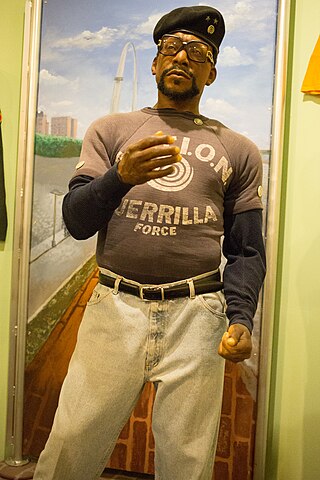Schnuck Markets, Inc., doing business as Schnucks, is a supermarket chain. Based in the St. Louis area, the company was founded in 1939 with the opening of a 1,000-square-foot (93 m2) store in north St. Louis and currently operates over 100 stores in four states throughout the Midwest. Schnucks also ran stores under the Logli Supermarkets and Hilander Foods banners. Schnucks is one of the largest privately held supermarket chains in the United States and dominates the St. Louis metro grocery market.

Fair St. Louis is an annual festival held during the United States Independence Day holiday in downtown St. Louis, Missouri, at the Gateway Arch National Park. It is funded by the Veiled Prophet Organization.

August Anheuser Busch Sr. was an American brewing magnate who served as the President and CEO of Anheuser-Busch, based in St. Louis, Missouri, from 1913 to 1934. It became the world's largest brewery in 1957 under direction of his son August A. "Gussie" Busch Jr.
The Veiled Prophet Parade and Ball was a yearly cult ceremony in St. Louis, Missouri, over which a mythical figure called the Veiled Prophet presided. The first events were in 1878 and were organized and funded by the Veiled Prophet Organization, an all-male secret society founded in 1878 by a highly select group of the city’s business and governmental leaders. In 2021, the parade was replaced in response to criticisms about corruption and racism.

Elizabeth Claire Kemper is an American actress, best known for her roles of Erin Hannon in the sitcom The Office (2009–2013) and Kimmy Schmidt in the sitcom Unbreakable Kimmy Schmidt (2015–2019). She has also appeared in films, notably Bridesmaids (2011), 21 Jump Street (2012), Sex Tape (2014), and Home Sweet Home Alone (2021). In 2018, she released her debut book, My Squirrel Days.

Firmin Desloge Hospital is a hospital in St. Louis, Missouri, opened in 1932 by the Jesuits of Saint Louis University and the Sisters of Saint Mary. Named for the benefactor, Firmin V. Desloge, it was established to serve the poor and others in need. Located on Grand Avenue between Vista Avenue and Rutger Avenue, Firmin Desloge Hospital was the main hospital building of the St. Louis University Medical Center until a new hospital was built and opened in 2020.
The Desloge family, centered mostly in Missouri and especially at St. Louis, rose to wealth through international commerce, sugar refining, oil drilling, fur trading, mineral mining, saw milling, manufacturing, railroads, real estate, and riverboats. The family has funded hospitals and donated large tracts of land for public parks and conservation.

Desloge Chapel is a Gothic church in St. Louis, Missouri. Located at Grand Avenue and Vista Avenue, it was designed by Gothic revivalist architect Ralph Adams Cram to echo the Sainte-Chapelle chapel in Paris.
William R. Orthwein Jr. was an American businessman and philanthropist.
Robert Ringen Hermann, Sr. was an American businessman, soccer executive from St. Louis, Missouri.

Percy Green II, born in the Compton Hill neighborhood of St. Louis, is a social worker and Black activist in St. Louis, Missouri. He was active in the St. Louis chapter of the Congress of Racial Equality (CORE), and was a founding member of ACTION. He was also the plaintiff in the landmark civil rights case McDonnell Douglas Corp v. Green, which remains among the most frequently cited cases in American jurisprudence. Green has fought for equality and black inclusion in the St. Louis region for nearly half a century. He is a member of the Peace Economy Project's board.
Rose Marion Boylan, known professionally as Rose Marion, was a newspaper reporter for more than forty-six years in the St. Louis, Missouri, area.

Marie Moentmann (1900–1974) was a 15-year-old girl who lost her hands and full use of both arms in a factory accident in 1915 in St. Louis, Missouri.

Alonzo William Slayback (1838–1882), a lawyer, was an officer in the Confederate Army and a founder of the Veiled Prophet Parade and Ball in St. Louis, Missouri. He was shot and killed in self-defense by the managing editor of the St. Louis Post-Dispatch.

Charles E. Slayback (1840–1924) was a grain merchant in New Orleans, Louisiana, and St. Louis, Missouri. He was a founder of St. Louis's Veiled Prophet Organization.

John G. Priest (1822–1900) was a businessman and social and civic leader in St. Louis, Missouri, in the latter part of the 19th century. He was the first Veiled Prophet representation of that city.

Walter B. Stevens (1848-1939) was a journalist and secretary and publicity director of the Louisiana Purchase Exposition Company and the author of books on the history of Missouri.

George Albert Raoul Soulie, known as George Soulie (1844-1919) was a French-born artist living and working in New Orleans, Louisiana, and St. Louis, Missouri.
The Black Veiled Prophet Ball was an observance in St. Louis, Missouri, beginning in 1967 in which an African-American man was named the Black Veiled Prophet and a woman the Black VP Queen. It was seen as a lampoon or a mockery of the whites-only Veiled Prophet Ball of that era.



























